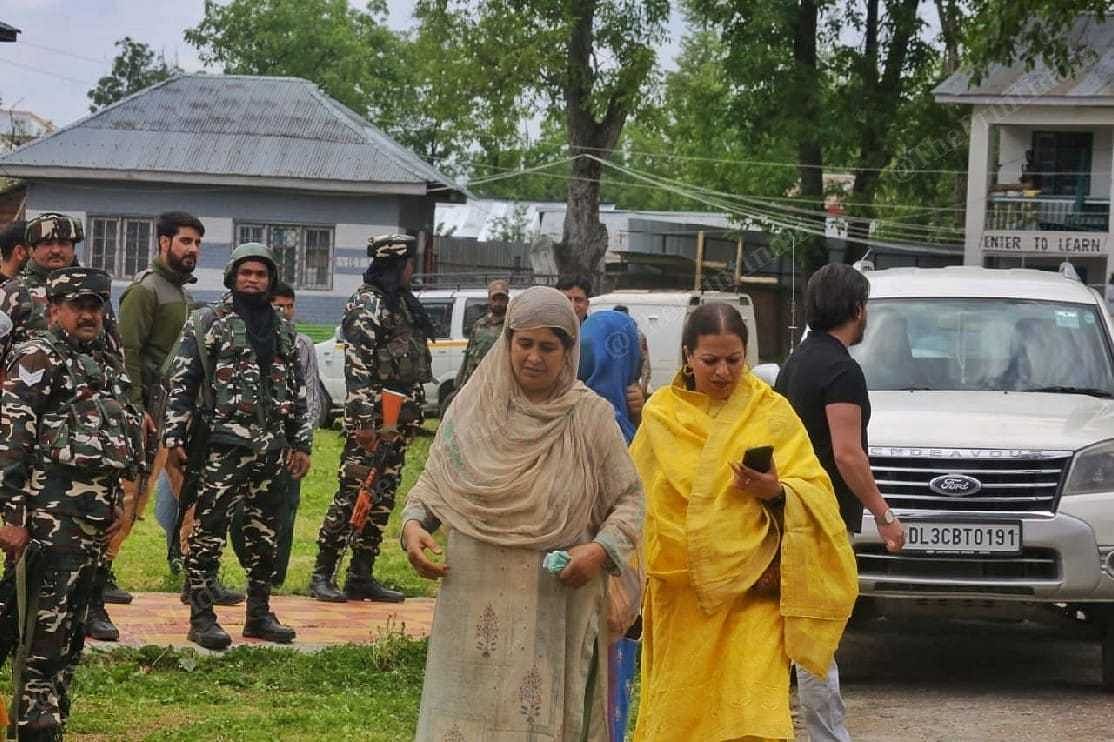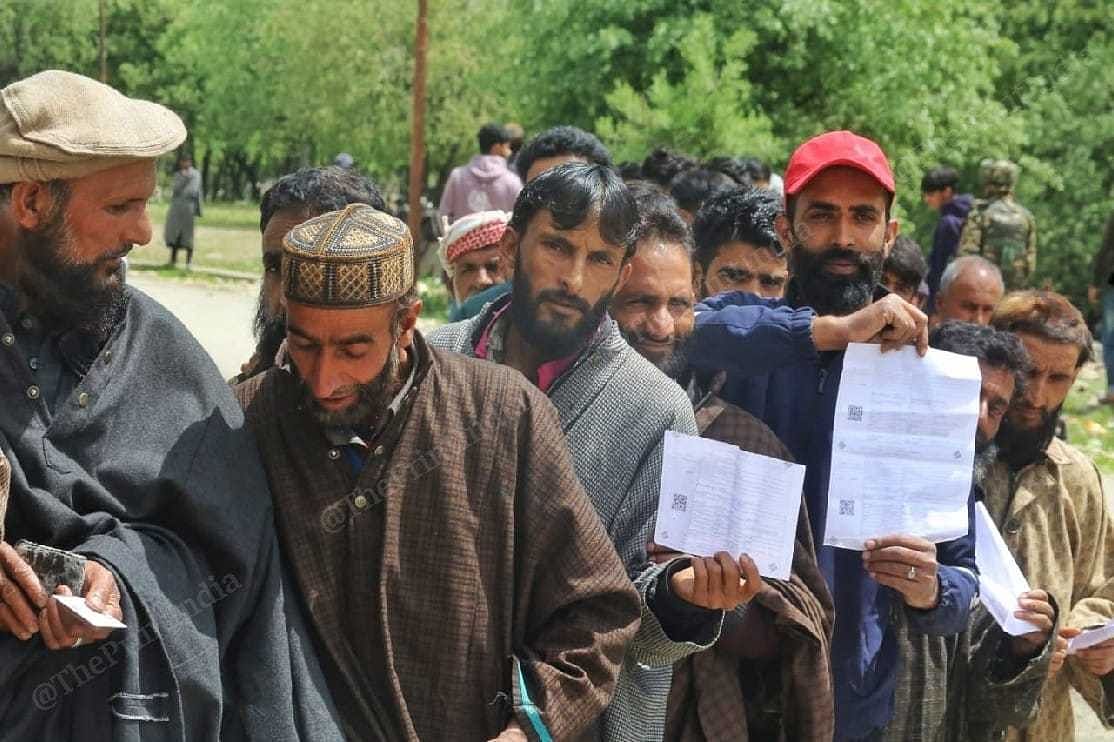Srinagar/Tral/Pulwama: At 7:30 am, amidst the chill of a post-rain morning, the scene at the Kakapora polling station in Pulwama unfolds as a stark departure from its turbulent past.
Historically marred by militant activities, including the devastating February 2019 Pulwama attack, which claimed the lives of 40 CRPF soldiers, this region had long been a symbol of voter apathy and fear.
Over the last two decades, voter turnout in Parliamentary elections hovered at a meager 1 to 2 percent, owing to calls by militants for boycotts. Stone-pelting incidents were rampant, and hartals were a norm.
However, on this Monday, as Srinagar polled, for the first time after abrogation of Article 370, Pulwama recorded an unprecedented 45 percent voter turnout.
Voters queued at the Kakapora booth, driven by a collective aspiration for the “betterment of Kashmir” and the desire to express their electoral mandate. Imtiaz Ahmed, a resident of Kakapora, Pulwama, highlighted the transformation, attributing the newfound confidence to the absence of boycott calls and threats.
“Here there was a lot of militancy, people were scared, there were bandh calls, so no one ever came out to vote. With no boycott calls and threats, we got the confidence to come out” he said.
Moreover, he emphasised the pressing need for political representation in Jammu and Kashmir, which has been under Governor’s rule since 2018. The surge in voter participation also marks a generational shift, with first-time voters and even individuals in their 50s and 60s casting ballots for the first time.
Their participation was fueled by the desire to elect representatives sensitive to their community’s challenges, with hopes of soon being able to choose their MLAs in forthcoming assembly elections.
“We want to make this election a success because we need political representation. Inshallah, we will have assembly elections soon,” he said.

A mere 20 km away, in Tral’s Dadasara — another militant stronghold and the hometown of the late Hizbul Mujahideen commander Burhan Wani, killed in 2016 — the voter turnout used to stagnate at a mere 0.05 percent.
However, Monday saw a remarkable surge, with turnout reaching 37.52 percent. When asked, voters expressed their desire to make their “voice heard” and to move towards progress, overcoming the losses they have endured in the past.
Similarly, in Drabgram, the hometown of slain Hizbul Mujahideen commander Sameer Ahmed Bhat alias Sameer Tiger, also saw significant polling.
Remarkably, other regions too, that were once hotbeds of militancy, such as Shopian, Tral, and Pulwama, voter turnout defied expectations, standing at 45%, 37.52%, and 39.25% respectively. This, polling officials deployed across booths said underscores a notable shift towards increased civic engagement and participation in these regions. In fact, the areas that were most affected by terrorism in the villages came out to vote more than the city.
The total voter turnout in Srinagar was recorded to be approximately 36 percent till 6 pm. In 2019, this was 13 percent and the highest voter turnout since 1989 was recorded in 1996 at 40.8 percent, according to data shared by J&K police.
Additional Director General Vijay Kumar told ThePrint that it is a huge success for Kashmir. “It is a success for the region that the election went off peacefully. There were no incidents of violence or terror reported, which is commendable. The voter turnout was extremely good. In some districts like Pulwama and Shopian highly terrorist infested areas, where the turnout was a mere 2-3 percent has seen over 45 percent voting,” the ADG asserted.
“What happened in Kashmir today is extremely significant. This shows that an enabling environment has been created for the people to come out and exercise their right to vote,” a senior government functionary in Srinagar said. “These areas that have voted the maximum were the worst affected by terrorism. These villages were hideouts of organisations like the Lashkar and Hizbul. The villagers would give them logistical support, shelter and food. Whenever there were calls of boycott, the villages would shut down but this time they have come in big numbers. This is unprecedented.”
While the National Conference has fielded Aga Ruhullah Mehdi, a former cabinet minister and Shia cleric, Apni Party’s candidate is Mohammad Ashraf Mir. The People’s Democratic Party (PDP) has nominated Waheed ur Rehman Parra, the former secretary of the state sports council and president of its youth wing.
Also Read: ‘To break silence, reclaim what we lost, representation’ — Srinagar sees highest turnout since 1996
‘From stone pelting to pressing button to cast vote’
Mushtaq, polling officer in Dadasara, Tral did not expect the voter turnout to be this much. He said that the polling at his booth reached 7 percent by 12 noon which he considers a “big success”. The polling percentage at this both used to range from 0 to 0.05 percent, he said.
“I have given duty at this poll in so many elections, and we would just sit and wait for people to come. It is so encouraging to see that so many people came to vote. The voting used to be negligible. Some people have voted after 25-28 years. This is a very significant improvement and it will only get better from here,” he said.

SSP Pulwama P.D.Nitya told ThePrint that such high voter turnout is very encouraging. She said that the area reported incidents of stone pelting on a regular basis and now those hands are being used to not pelt stones but cast a vote to exercise their right.
“There were no boycott calls, and all parties were urged to participate. It is a positive thing that our efforts paid off. Kakapora was a hotbed of militants. Every day there was stone pelting and the voting was not less than 1 to 2 percent. This had become an expected norm for this region. But things have changed significantly. Look, so many people have queued up to exercise their right to vote,” she said.
Altaf Thakur, J&K BJP spokesperson who was at the Dadasara polling station in Tral, said that a good voter turnout was possible due to the efforts of the central government.
“After 2019 there has been a big change. There is peace, development happening. People’s thinking has changed. Here in Dadasara 175 militants have been buried. This was a hotbed. Network of terrorism used to operate from here, but now people are coming out to vote to celebrate the festival of democracy. This is the change we have been talking about. Here, there used to be zero percent vote,” he said.
(Edited by Tony Rai)
Also Read: How BJP is using 2024 Lok Sabha election to lay groundwork for post-Modi succession plan